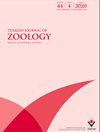Evaluation of the feeding patterns of important mosquito vector species using molecular techniques
IF 1.3
4区 生物学
Q2 ZOOLOGY
引用次数: 0
Abstract
: This study investigated the feeding patterns of populations of Anopheles sacharovi, Culex tritaeniorhynchus, and Culex pipiens in the Mediterranean and Aegean regions of Turkey. Blood-fed females resting inside barns, houses, and chicken coops in the rural areas were collected between May 2017 and September 2019, and the genomic DNA from each female was isolated to determine the blood source after amplification of the mitochondrial cytochrome b gene region. Cytb results showed that out of 445 blood-fed An. sacharovi females 2 blood-fed from dogs, 9 from birds, and 434 from cows. The results also showed that all 216 blood-fed females Cx. tritaeniorhynchus captured fed from cows, 6 out of 97 Cx. pipiens females fed from horses and 91 from birds. The feeding pattern of mosquito populations can be affected by numerous factors such as sampling method, sample size, and host abundance. Although field studies on mosquito feeding patterns do not reveal the feeding preference of such vectors, they provide vital information to understanding of vector and host interactions in the research area. Moreover, these data can give an idea of possible human contact in an environment where various hosts are readily accessible to a given vector mosquito; this is important for the prevention of various human diseases caused by vector mosquitoes.应用分子技术评价重要媒介蚊种的取食方式
本研究调查了土耳其地中海和爱琴海地区萨哈罗维按蚊、三带喙库蚊和淡纹库蚊的取食方式。2017年5月至2019年9月,在农村地区的畜舍、房屋和鸡舍内收集了血液喂养的雌性动物,并对每只雌性动物的基因组DNA进行分离,扩增线粒体细胞色素b基因区域,以确定血液来源。Cytb结果显示,在445例血供An。萨卡罗维雌性2只取自狗的血液,9只取自鸟的血液,434只取自牛的血液。结果还表明,所有216只经血喂养的雌性Cx。从奶牛身上捕获的三带喙蚊,97只中有6只。雌性库蚊从马身上喂养,91只从鸟身上喂养。蚊虫的取食方式受采样方法、样本量、宿主数量等因素的影响。尽管对蚊子取食模式的实地研究并未揭示这些媒介的取食偏好,但它们为了解研究领域媒介与宿主的相互作用提供了重要信息。此外,这些数据可使人们了解在某一媒介蚊子容易接触到各种宿主的环境中可能发生的人类接触;这对于预防由病媒蚊子引起的各种人类疾病非常重要。
本文章由计算机程序翻译,如有差异,请以英文原文为准。
求助全文
约1分钟内获得全文
求助全文
来源期刊

Turkish Journal of Zoology
ZOOLOGY-
CiteScore
2.30
自引率
10.00%
发文量
24
审稿时长
6-12 weeks
期刊介绍:
The Turkish Journal of Zoology is published electronically 6 times a year by the Scientific and Technological Research Council of Turkey (TÜBİTAK).
-Accepts English-language manuscripts in various fields of zoology including systematics, developmental biology, behaviour biology, animal models, molecular biology and molecular phylogeny, genomics, physiology (cell communication and signaling systems), biochemistry and immunohistochemistry, applied parasitology and pathology, nanobiotechnology, ecology, evolution, and paleontology of animal taxa.
-Contribution is open to researchers of all nationalities.
-Short communications are also welcome, such as reports of a preliminary nature or those including new records from specific localities or regions, and the editor reserves the right to decide that a paper be treated as a short communication.
-The papers that deal with purely checklists, new host and non-regional new locality records will not be consider for publication.
-Letters to the editor reflect the opinions of other researchers on the articles published in the journal. The editor may also invite review articles concerning recent developments in particular areas of interest.
 求助内容:
求助内容: 应助结果提醒方式:
应助结果提醒方式:


